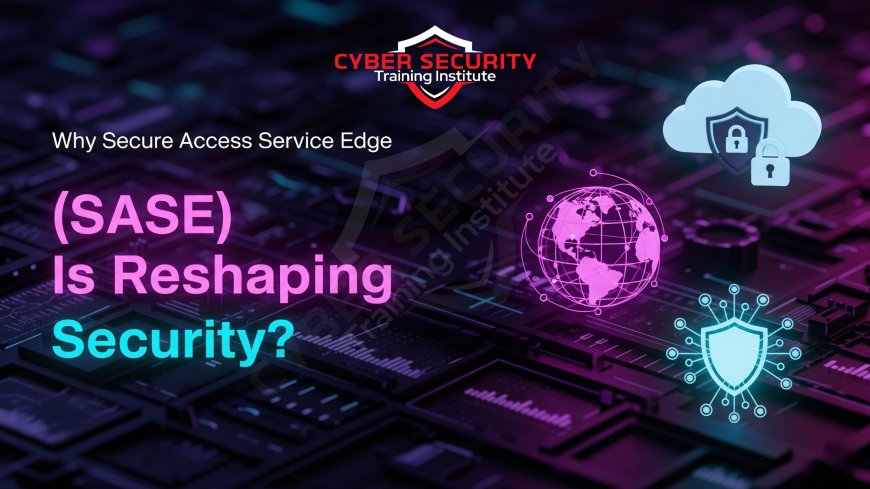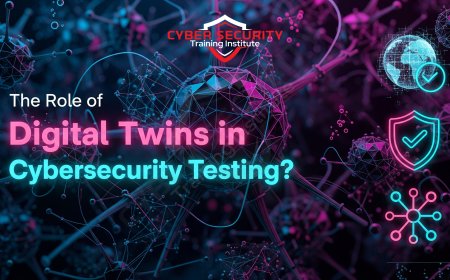Why Secure Access Service Edge (SASE) Is Reshaping Security
The traditional "castle-and-moat" model of network security is obsolete in a world where users are everywhere and applications are in the cloud. This in-depth article explains why Secure Access Service Edge (SASE) is the revolutionary new architecture that is reshaping modern security. We break down the core problems of the old, data-center-centric model, such as the inefficient "hairpinning" of traffic through a VPN, and detail how SASE solves these issues. Discover the core components of the SASE framework—the convergence of cloud-native security services (SSE) and software-defined networking (SD-WAN)—and learn how this new model enforces consistent, powerful security at the edge, close to the user. The piece features a comparative analysis that clearly illustrates the advantages of the decentralized, Zero Trust-based SASE model over the traditional, perimeter-focused approach. We also explore how SASE is not just a security framework, but a critical business enabler for the modern, agile, and distributed enterprise. This is an essential read for any IT or security leader looking to understand the most significant architectural shift in network security and how to build a defense that is fit for a borderless, cloud-first world.

Introduction: The Crumbling Castle Walls
For decades, our approach to network security was simple and resembled a medieval castle. We built a strong wall and a deep moat—our corporate firewall—around the central office, assuming that anyone inside those walls was a trusted friend. But what happens when there is no single office anymore? What happens when your users are everywhere, and your most important applications are in the cloud? The castle walls have crumbled. This new reality demands a new security architecture, and that architecture is SASE. Secure Access Service Edge (SASE), pronounced "sassy," is a revolutionary new model that is reshaping security because it converges networking and security into a single, cloud-native service, enforces security at the edge close to the user, and provides a unified, identity-driven approach that is perfectly built for the modern, distributed, and cloud-first enterprise.
The Problem SASE Solves: The Failure of the "Hairpin"
To understand why SASE is so revolutionary, you have to understand the old, broken model it replaces. In the traditional "castle-and-moat" architecture, the corporate data center was the center of the universe. All of the company's security services—the firewall, the web filter, the intrusion prevention system—were physical appliances that lived in that data center.
This worked fine when all the employees were in the office. But it created a massive problem for the modern remote worker. Imagine an employee working from home who needs to access a cloud application like Salesforce or Microsoft 365. In the old model, their internet traffic would first have to travel all the way from their home to the corporate data center through a slow and clunky Virtual Private Network (VPN). There, it would be inspected by the firewall. Then, it would have to travel all the way *back out* to the internet to finally reach the cloud application. This inefficient back-and-forth traffic flow is known as the "hairpin" or "trombone" effect. It's incredibly slow, it creates a terrible user experience, and it's a highly inefficient way to run a modern business. .
The Core Components of SASE: Converging Two Worlds
SASE is not a single product; it is an architectural framework that is built on the convergence of two traditionally separate worlds: networking and security. It brings them together into a single, cloud-delivered service.
- The Networking Side (WAN Edge Services): This part of SASE is focused on efficiently and intelligently connecting users to applications. The primary technology here is SD-WAN (Software-Defined Wide Area Network). An SD-WAN can intelligently route traffic over the most optimal path. Instead of always backhauling traffic to the central data center, it can send traffic destined for a cloud application directly to the cloud, dramatically improving performance.
- The Security Side (Security Service Edge - SSE): This is a complete stack of security services that are no longer physical appliances in your data center. Instead, they are delivered as a service from the cloud. The core components of the SSE are:
- Firewall as a Service (FWaaS): A cloud-based firewall that enforces security policies.
- Secure Web Gateway (SWG): A cloud-based web filter that protects users from malicious websites and content.
- Cloud Access Security Broker (CASB): A tool that provides visibility and control over the SaaS applications that users are accessing.
- Zero Trust Network Access (ZTNA): A modern replacement for the VPN that grants users access only to specific applications they are authorized for, not the entire network.
A true SASE solution is the tight integration of both of these sides into a single, unified platform.
How SASE Works in Practice: Security at the Edge
So how does this all work for the end-user? The SASE model distributes both the networking and the security functions to a global network of small data centers known as "Points of Presence" (PoPs). When a remote user wants to access an application, their traffic is first directed to the nearest PoP.
The process looks like this:
- The user, working from home, tries to access a corporate application. Their device automatically connects to the closest SASE PoP, which might be just a few miles away.
- The SASE service, operating at this "edge" location, first verifies the user's identity and the security posture of their device. This is the Zero Trust part of the equation.
- Once the user is authenticated, the SASE service inspects their traffic, applying all the necessary corporate security policies—the firewall rules, the web filtering, the data loss prevention—right there at the edge.
- Finally, the service intelligently routes the now-secured traffic directly to its destination. If it's a public cloud app, it goes straight to the internet. If it's a private application in the corporate data center, it's sent through a secure tunnel.
The result is that the user gets a fast, direct, and seamless connection, and the company gets a consistent and powerful security posture for every user, no matter where they are or what application they are accessing. .
Comparative Analysis: Traditional Network Security vs. SASE
SASE represents a complete architectural and philosophical shift away from the centralized, perimeter-based security model of the past.
| Aspect | Traditional "Castle-and-Moat" Model | Secure Access Service Edge (SASE) Model |
|---|---|---|
| Architecture | Is centralized and hardware-based. All of the security policies were enforced by a stack of physical appliances in the corporate data center. | Is decentralized and cloud-native. Security is a software service that is delivered from a global network of edge locations (PoPs). |
| The Security Perimeter | The security perimeter was the physical wall of the data center. The goal was to protect the "inside" from the "outside." | The security perimeter is the identity of the user and the device, wherever they may be located. The perimeter is now everywhere. |
| User Experience | Was often slow, cumbersome, and frustrating for remote users due to the performance penalty of VPN backhauling (the "hairpin" effect). | Provides a fast, direct, and seamless connection to all applications, both cloud and private, for all users, regardless of location. |
| Management Complexity | Required security teams to manage a complex stack of different, physical security appliances, often from multiple different vendors. | Provides a single, unified platform that allows a team to manage both networking and security policies from a single, cloud-based console. |
| Core Security Model | Was based on a "trust but verify" model, where anyone who was inside the network (e.g., on the VPN) was considered generally trusted. | Is built on a foundational "Zero Trust" model, where every single access request is verified, regardless of the user's location. |
The Business Enabler for the Modern Enterprise
In today's global economy, the modern, agile enterprise is defined by its distributed nature. The workforce is hybrid, critical applications are delivered as SaaS, and business is conducted from anywhere and everywhere. The old, data-center-centric security model is a direct barrier to this new way of working. It is slow, it is complex to manage, and it cannot provide a consistent security policy for a user who is working from the corporate office one day and from their home the next.
SASE is becoming the new security standard because it is an architecture that is purpose-built for this new reality. It is not just a security model; it's a business enablement model. It allows an organization to securely connect any user, on any device, in any location, to any application, with a single, unified set of security policies that are enforced consistently everywhere. It removes the friction of the old VPN model and provides the agility that modern businesses need to compete, all while dramatically improving their security posture. It is the network architecture for the way we work now.
Conclusion: The New Perimeter for a Borderless World
SASE is a fundamental and necessary reshaping of network security. It is a direct response to a world where the old, simple perimeter has been shattered by the forces of cloud computing and remote work. By converging the previously separate worlds of networking and security into a single, cloud-native service, SASE provides a solution that is more secure, more efficient, and far simpler to manage.
It provides a far better and faster user experience for employees, and it provides the business with the agility it needs to thrive. But most importantly, it is built on a modern, foundational security philosophy of Zero Trust. The old perimeter is gone. SASE is the new, dynamic, and identity-driven perimeter for the modern, borderless enterprise.
Frequently Asked Questions
What does SASE stand for?
SASE stands for Secure Access Service Edge. It is an architectural framework for network security that is delivered from the cloud.
What is the difference between SASE and SSE?
SASE is the full framework that combines both networking (SD-WAN) and security. SSE, or Security Service Edge, refers specifically to the security side of the SASE model—the cloud-delivered stack of security services like ZTNA, SWG, and CASB.
What is SD-WAN?
SD-WAN, or Software-Defined Wide Area Network, is a technology that uses software to intelligently and dynamically route network traffic over the most optimal path, rather than just sending everything back to a central data center.
What is Zero Trust Network Access (ZTNA)?
ZTNA is a modern replacement for the traditional VPN. Instead of giving a user access to the entire network, ZTNA provides access only to the specific applications that the user is authorized to use, based on a strong verification of their identity.
What is the "hairpin" effect?
The "hairpin" or "trombone" effect is an inefficient network traffic pattern where a remote user's traffic has to go all the way to a central corporate data center and then back out to the internet to reach a cloud application. SASE eliminates this.
What is a "Point of Presence" (PoP)?
A PoP is a small, distributed data center that is part of a larger global network. A SASE provider will have hundreds of these PoPs around the world to ensure that a user can always connect to one that is close to them, which reduces latency.
Is SASE a single product I can buy?
While SASE is an architectural framework, many vendors now offer a single, unified platform that combines all the core networking and security components into one integrated, cloud-managed service.
Why is SASE better for remote work?
Because it provides a faster, more direct connection for remote workers to their cloud applications, and it ensures that the same, strong security policy is applied to them no matter where they are working from.
What is a Secure Web Gateway (SWG)?
An SWG is a security solution that filters all of a user's web traffic to block malicious websites, prevent malware downloads, and enforce corporate browsing policies.
What is a Cloud Access Security Broker (CASB)?
A CASB is a security tool that provides visibility and control over the cloud-based SaaS applications that a company's employees are using. It can enforce security policies for services like Microsoft 365 and Google Workspace.
What is a "cloud-native" service?
A cloud-native service is one that was designed and built from the ground up to run in the cloud. It is typically distributed, scalable, and delivered as a service, just like a SASE platform.
Does SASE replace my company's firewall?
It replaces the need for a traditional, hardware-based firewall at the perimeter of every branch office. The firewall functionality is moved to the cloud and delivered as a service (FWaaS) from the SASE platform.
What does "backhauling" traffic mean?
Backhauling is the process of redirecting all traffic from a remote user or a branch office back to the central corporate data center for security inspection. It is the process that causes the "hairpin" effect.
Is SASE related to Zero Trust?
Yes, they are deeply related. The Zero Trust philosophy of "never trust, always verify" is a foundational principle of the SASE architecture. SASE is one of the primary ways to implement a Zero Trust model for a modern, distributed workforce.
What does it mean for a network to be "converged"?
In this context, "converged" means that the traditionally separate functions of networking (connecting things) and security (protecting things) have been combined into a single, unified platform.
What is a VPN?
A VPN, or Virtual Private Network, is the traditional technology used to provide remote users with a secure, encrypted connection to a private corporate network. ZTNA is the modern successor to the VPN in a SASE model.
What is "latency"?
Latency is the time delay in a network. Backhauling traffic to a distant data center increases latency, which makes applications feel slow. SASE reduces latency by processing traffic at a nearby edge location.
Do I need SASE if all my employees are in the office?
Even for office-based employees, a SASE architecture can be beneficial. It can simplify the management of your security stack and provide a more efficient, direct path to the cloud applications that your employees use every day.
What is the biggest management benefit of SASE?
The biggest management benefit is simplification. It allows a security team to manage a single, unified security policy for all users and all applications from a single cloud-based console, instead of having to manage a complex stack of different physical appliances.
What is the future of network security?
The future is SASE. The architectural shift to a distributed, cloud-delivered, and identity-driven security model is widely seen as the inevitable and necessary evolution to meet the needs of the modern enterprise.
What's Your Reaction?
 Like
0
Like
0
 Dislike
0
Dislike
0
 Love
0
Love
0
 Funny
0
Funny
0
 Angry
0
Angry
0
 Sad
0
Sad
0
 Wow
0
Wow
0







![How to Install RHEL 10 on VMware/VirtualBox [Tutorial]](https://www.cybersecurityinstitute.in/blog/uploads/images/202509/image_430x256_68b56dc967a4a.jpg)







